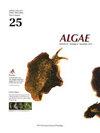The description of Haematococcus privus sp. nov. (Chlorophyceae, Chlamydomonadales) from North America
IF 2.4
3区 生物学
Q1 MARINE & FRESHWATER BIOLOGY
引用次数: 0
Abstract
An enormous body of research is focused on finding ways to commercialize carotenoids produced by the unicellular green alga, Haematococcus, often without the benefit of a sound phylogenetic assessment. Evidence of cryptic diversity in the genus means that comparing results of pigment studies may be confounded by the absence of a phylogenetic framework. Moreover, previous work has identified unnamed strains that are likely candidates for species status. We reconstructed the phylogeny of an expanded sampling of Haematococcus isolates utilizing data from nuclear ribosomal markers (18S rRNA gene, 26S rRNA gene, internal transcribed spacer [ITS]-1, 5.8S rRNA gene, and ITS-2) and the rbcL gene. In addition, we gathered morphological, ultrastructural and pigment data from key isolates of Haematococcus. Our expanded data and taxon sampling support the concept of a new species, H. privus, found exclusively in North America. Despite overlap in numerous morphological traits, results indicate that ratios of protoplast length to width and akinete diameter may be useful for discriminating Haematococcus lineages. High growth rate and robust astaxanthin yield indicate that H. rubicundus (SAG 34-1c) is worthy of additional scrutiny as a pigment source. With the description of H. privus, the evidence supports the existence of at least five, species-level lineages in the genus. Our phylogenetic assessment provides the tools to frame future pigment investigations of Haematococcus in an updated evolutionary context. In addition, our investigation highlighted open questions regarding polyploidy and sexuality in Haematococcus which demonstrate that much remains to be discovered about this green flagellate.北美洲女贞血球藻属(绿藻科,衣藻目)的记述
大量的研究集中在寻找由单细胞绿藻红球藻生产的类胡萝卜素商业化的方法上,通常没有一个健全的系统发育评估。该属中隐藏多样性的证据意味着色素研究的比较结果可能因缺乏系统发育框架而混淆。此外,以前的工作已经确定了未命名的菌株,可能是物种地位的候选者。我们利用核糖体标记物(18S rRNA基因、26S rRNA基因、内部转录间隔物[ITS]-1、5.8S rRNA基因和ITS-2)和rbcL基因的数据重建了扩增的红球菌分离物的系统发育。此外,我们收集了红球菌关键分离株的形态、超微结构和色素数据。我们扩大的数据和分类群抽样支持一个新物种的概念,H. privus,只在北美发现。尽管在许多形态特征上存在重叠,但结果表明原生质体的长宽比和镰刀菌直径可能对区分红球菌谱系有用。高生长率和强大的虾青素产量表明,H. rubicundus (SAG 34-1c)作为色素来源值得进一步研究。根据对H. privus的描述,证据支持该属中至少存在五个种级谱系。我们的系统发育评估提供了工具,框架在一个更新的进化背景下,未来的红球菌色素研究。此外,我们的调查突出了关于红球菌多倍体和性行为的开放性问题,这表明关于这种绿色鞭毛虫还有很多有待发现的地方。
本文章由计算机程序翻译,如有差异,请以英文原文为准。
求助全文
约1分钟内获得全文
求助全文
来源期刊

Algae
PLANT SCIENCES-
CiteScore
5.10
自引率
25.00%
发文量
18
期刊介绍:
ALGAE is published by the Korean Society of Phycology and provides prompt publication of original works on phycology. ALGAE publishes articles on all aspects of phylogenetics and taxonomy, ecology and population biology, physiology and biochemistry, cell and molecular biology, and biotechnology and applied phycology. Checklists or equivalent manu-scripts may be considered for publication only if they contribute original information on taxonomy (e.g., new combinations), ecology or biogeography of more than just local relevance. Contributions may take the form of Original Research Articles, Research Notes, Review Articles and Book Reviews.
 求助内容:
求助内容: 应助结果提醒方式:
应助结果提醒方式:


